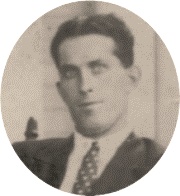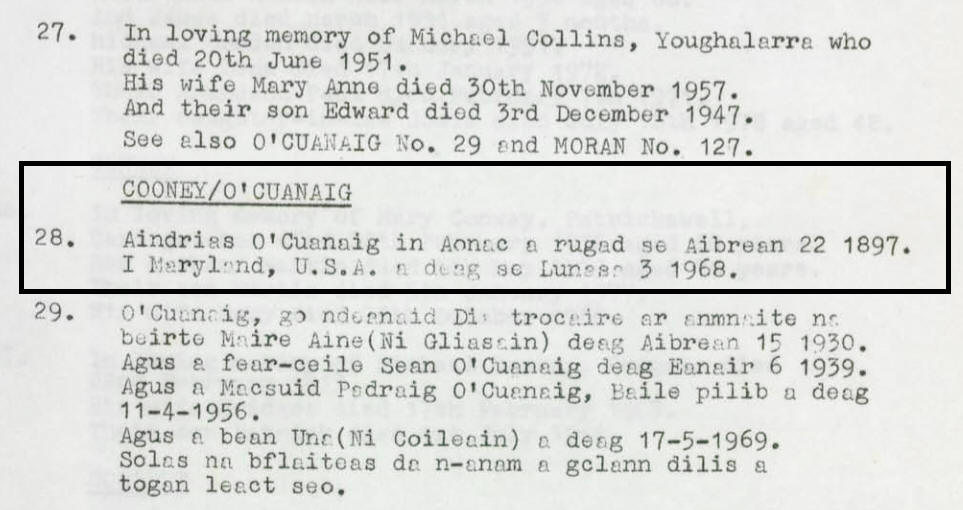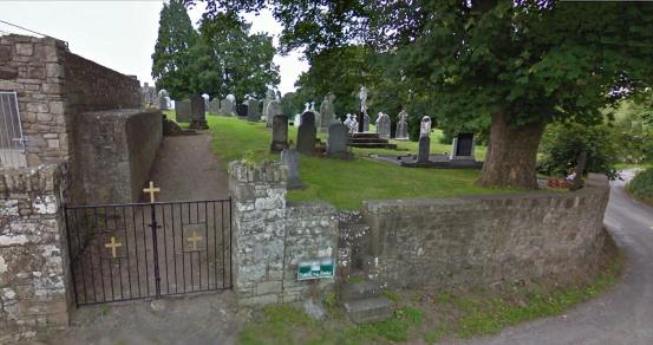Dr. Andy
Cooney (1897 – 1968)
Medical Doctor, Chief of Staff of
the IRA, Orator, Humanitarian,
Veteran of the Irish War of Independence and the Treaty War
 Andy
Cooney, the second of three children, was born
on April 22, 1897 to John Cooney and Mary Anne
Cooney, (née Gleeson) in Ballyphilip, Nenagh,
Co. Tipperary.
Andy
Cooney, the second of three children, was born
on April 22, 1897 to John Cooney and Mary Anne
Cooney, (née Gleeson) in Ballyphilip, Nenagh,
Co. Tipperary.
As a young man Cooney’s father, John, studied for the priesthood at a seminary (possibly the Franciscan Friary) in Ennis in Co. Clare. When the Bishop of Killaloe found out that John’s father, Patrick, was a member of the Irish Republican Brotherhood and a Land League activist, he expelled John from his novitiate, since the Church would not take a chance on young men with a history of defiance or critical thought in the family’s background.
After that snub by the Church, Cooney’s father became a landowner, a phenomenon hitherto impossible prior to the enactment of several Irish Land Acts precipitated by the Land Wars of the late 1870s and early 1880s, and afterward by a continuous prolonged period of agrarian agitation led by the Irish National Land League. The so-called Wyndham Land (Purchase) Act 1903 was the culmination of the above-mentioned Land Acts that made it easier for tenant farmers to purchase the land they tilled. It also heralded the death knell for landlordism in Ireland.
Despite his father’s activism, John Cooneydid not engage in the political and cultural nationalistic movements that dominated the national discourse in Ireland during the later decades of the 19th century and early decades of the 20th century.
After completing his primary education at the nearby Lissenhall National School in 1911 Andy continued with his secondary education at the Christian Brothers School in Nenagh. In 1916 he was admitted to University College Dublin (UCD) as a medical student. As Latin was a prerequisite for admittance, he took the required courses at the O’Connell Secondary School in Dublin before entering UCD.
Cooney’s arrival in Dublin in 1915 coincided with a convergence of the many nationalistic, political, cultural, gender equality and labor movements molding, shaping and laying claim to a sovereign Ireland and its resources. The overriding aim of each of these movements that bound them together found expression in the 1916 Proclamation of the Irish Republic, purpose in the consequent Easter Rising and resolve in the martyrdom of its leaders at the hands of the foreign usurper.
With no prior exposure to the said movements nor insight into their motives, Cooney was content to pursue his medical studies. Being a native of Tipperary where hurling was an enduring and shared passion he instinctively became a member of the UCD hurling club. During his years at UCD he was on the Collegians team that won the Dublin Championship in 1918 and 1919 and later, after an absence of several years due his participation the War of Independence and subsequent Treaty War, on the team that won the Fitzgibbon Cup in 1926/27.
The audaciousness of the Rising and the courage, tenacity and resolve displayed by the relatively few who faced the might of the British Empire challenged Andy's sense of complacency and caused him to consider his own role in Ireland’s freedom struggle. Cooney was not alone in that regard. The executions of the Rising’s leaders followed by the arrest and internment of 3,430 men and 79 women, the indiscriminate killing of 42 innocent children by British soldiers during the week of the Rising, the execution style killing of pacifist Francis Sheehy Skeffington and two journalists by a British army officer in Portobello Barracks and the North King Street Massacre where on the night of April 28–29 British soldiers burst into houses on North King Street and shot or bayoneted 15 male civilians, robbed and then buried them in cellars and backyards --- all these deliberate atrocities at last awakened the Irish people to the fact that colonial rule was not a force for good as they were led to believe but a ubiquitous evil that destroyed cultures and the tranquility and traditions of native peoples, including theirs.
After the executions in May of 1916 through June of 1917 very little of a military nature occurred in Ireland as most of the fighting men and women were interned. However, the courageous women of Cumann na mBan were back in action organizing prisoner relief groups, propagating the memory of the 1916 leaders and exposing the brutality of the British army during and after the Easter Rising. To that end several Republican women including Nora Connolly and Hanna Sheehy Skeffington toured the United States lecturing on the Easter Rising and raising funds for the Republican cause.
The one issue that posed an immediate problem for the British after the Easter Rising was a precipitous fall-off in British army recruitment. To counter that problem, they started to release some of the interned men and women, mostly those whom they knew were not directly involved with the Rising. Their problem was compounded when John Redmond’s Irish-born union jack soldiers returning from the Western Front and the Dardanelles were treated as pariahs and shunned for fighting for England, Ireland’s tormentor. The new heroes were the Volunteer men and women returning from British prisons and internment camps.
In June of 1917 the British government granted the remaining prisoners a general amnesty purportedly to create a favorable atmosphere for peace negotiations and hopefully from their perspective, reverse the decline in young Irishmen joining their army. On their return home the Volunteers were greeted as heroes by large and enthusiastic crowds. Instead of clamoring for a peace deal as the British expected, the new leadership that emerged from Frongoch Internment Camp and British prisons set about recruiting and reorganizing the Volunteers for the next phase of the freedom struggle. It was at that time that Cooney joined C Company, 3rd Battalion, Dublin Brigade of the Irish Volunteers.
Cooney, and his friend Joe Keane who introduced him to the Volunteers, had no interest in Sinn Fein or the political aspect of the struggle. Despite that stance, Cooney volunteered to provide security for Sinn Fein voters at a by-election in south Armagh in February 1918 in which the Sinn Fein candidate lost to the Irish Parliamentary Party candidate.
Apart from his stewardship assignment in south Armagh, Cooney spent most of his time drilling and training with his battalion. Consequently, his medical studies suffered causing him to miss or fail some of his exams. In June of 1918, after the leadership ordered the Volunteers to drill in full view of the public he was arrested with other Volunteers while drilling in plain sight of the police and British intelligence. At a subsequent court appearance, he was sentenced to two months in prison, which he served in Crumlin Road Jail in Belfast.
After his release Cooney was initiated into the Irish Republican Brotherhood by Simon Donnelly a veteran of the Easter Rising. Having temporarily dropped out of UCD due to his imprisonment and having no other business in Dublin he returned home to Tipperary where he assisted the North Tipperary Battalion, which was coping with a surge in recruitment(1), organize and train its Volunteers.
In addition to the training of new recruits, the leadership realized that the acquisition of arms was also a priority that needed to be dealt with. To that end they embarked on a multifaceted approach that involved taking possession of arms from sympathizers, raiding the homes of loyalists and taking their weapons and, after the onset of the War of Independence in January of 1919, raiding armories, police barracks and coastguard stations.
It is believed that Cooney took part in some of these activities including a raid on Castle Otway owned by a retired British army officer in September of 1918. The raid yielded several weapons and a few hundred rounds of ammunition and was carried out without incident. After the raid it was discovered that a ceremonial sword was taken by one of the Volunteers. It was decided to return the sword to the owner who gave them another revolver for their ‘noble gesture’. Cooney was part of a contingent of Volunteers who went to hostile Waterford to protect Sinn Fein voters in the General Election in December of 1918.
Cooney returned to Dublin in January of 1919 to resume his studies at UCD and, coincidentally, bear witness to the first meeting of Dail Eireann in the Mansion House on January 21. It was at that meeting that Ireland was declared an independent Republic. Of the 73 Sinn Fein members elected in the 1918 General Election only 46 were in attendance --- the other 27 were in prison for, in one way or another, opposing British rule in Ireland. Cooney was a steward at that meeting.
On the same day at Soloheadbeg in Co. Tipperary two Royal Irish Constabulary (RIC) constables escorting a consignment of explosive were killed by Irish Volunteers led by Dan Breen and Seán Treacy. That action, which became known as the Soloheadbeg Ambush heralded the beginning of the Irish War of Independence.
Cooney remained in Dublin until he succeeded in passing his first-year medical exam in the summer of 1919 and his second-year exam in the summer of 1920. During that same period, he remained active with his battalion, although probably not as a member of an Active Service Unit (ASU). Members of ASU were paid full time Volunteers who were generally on the move andaway from home.
After completing his exams in the summer of 1920, Cooney returned home to Tipperary where he resumed his work with the North Tipperary Battalion. In preparation for a planned raid on the Borrisokane Barracks, he was sent back to Dublin with another Volunteer to procure the hand grenades and bombs needed to carry out the raid. During the subsequent raid that took place on June 26, Cooney was one of the Volunteers who dropped bombs and hand grenades through a hole they had made in the roof. Although the interior of the building was destroyed, the Volunteers, who had standing orders to withdraw before daybreak, did not manage to force the RIC defenders to surrender. Nonetheless, the destroyed barracks was abandoned the next day.
After the summer holidays Cooney returned to Dublin where he became a member of an ASU. Consequently, he had to take time off from his medical studies which at that stage required hospital-based training, an unsustainable predicament for an ASU Volunteer.
As an ASU
Volunteer, Cooney was required to be available
for any operation or assignment ordered by his
superiors. On November 21, 1920 he was selected
to assist the Squad assassinate
members of the so-called Cairo Gang,
British intelligence agents brought into Ireland
to eliminate Collins and other Irish
Republican Army (IRA) leaders. The Squad
consisted of 12 hand-picked Volunteers under the
control of Michael Collins whose
primary purpose was to assassinate British
intelligence officers and informers. For
large-scale operations other ASU Volunteers were
brought in to augment the Squad.
Cooney was attached to the hit squad that
assassinated five of the British agents at 28
Upper Pembroke Street. In all 15 hit squads,
averaging 15 men per squad took part in the
raids. Nineteen British agents were shot of whom 15
were killed. Twelve other targets escaped, some of
whom took refuge in Dublin Castle,
while others fled back to England. Later that day British army units entered
Croke Park and opened fire on spectators
watching a football game between Dublin and
Tipperary, killing 14 and wounding
another 60. That massacre became known as
Bloody Sunday.
Towards the end of 1920 Cooney was promoted to the rank of Staff Captain attached to General Head Quarters (GHQ) staff. In January of 1921 he was sent to Kerry to help reorganize the No. 2 south Kerry Brigade and set up a flying column. The Volunteers selected to man the flying column were trained in the use of rifles, grenades and mine laying in the mountainous Gap of Dunloe.
On March 5, 1921 the newly formed flying column, in collaboration with the Cork no 2 Brigade, ambushed a contingent of British soldiers guarding General Hanway Cummins who was inspecting troops billeted in Kerry. The ambush, which took place at Clonbanin in Co. Cork, resulted in the killing of General Cummins and 12 soldiers and the wounding of 15 others.
Shortly afterwards, on the afternoon of March 21, another ambush, organized and executed by the south Kerry Brigade took place at Headford Junction railway station. Enroute from Kenmare to Killarney (30) Royal Fusiliers in the process of changing trains were fired upon by Volunteers lying in wait. Eight were killed and another eleven wounded. Two Volunteers and two civilians were also killed. Afterwards, Cooney had difficulty convincing the Chief of Staff, Richard Mulcahy, that it was the south Kerry flying column and not a Cork one that carried out the ambush.
The Anglo-Irish Truce of July 11, 1921 brought an ending to the Irish War of Independence. The preconditions set forth by Lloyd George, and agreed to by de Valera, for the ensuing peace negotiations essentially formed the basis for the Anglo-Irish Treaty signed on December 6, 1921. The lopsided Treaty was rejected by a majority of IRA officers and Volunteers on the basis that the Dail, by approving the Treaty had violated its sworn duty to protect and defend the Irish Republic proclaimed in 1916. Subverting the Irish Republic was the Rubicon that Irish Republicans, including Cooney, could not cross. For Irish Nationalists, a convoluted version of Home Rule in a partitioned Ireland was obviously enough. Thus, the perfect scenario for a counterrevolution was in place, a counterrevolution financed, provisioned and orchestrated by the British to eviscerate the fledgling Irish Republic.
On January 16, 1922 Ernie O’Malley, the commander of the 2nd Southern Division of the IRA renounced the authority of the General Head Quarters (GHQ). In the following months that renunciation was repeated by other divisions and brigade commanders and inevitably led to a division within the IRA between those who supported and those who opposed the Treaty. In the anti-Treaty Republican camp, Cooney was appointed Officer Commanding (O/C) of the 1st Kerry Brigade of Republican forces and shortly thereafter Commandant of the 1st Eastern Division of Republican forces.
From March to the onset of the Treaty War (Civil War) in late June of 1922 several stand-offs and clashes occurred between the opposing factions in Limerick, Athlone and Kilkenny. On April 14, the Four Courts building in Dublin was occupied by 150 to 200 Republican Volunteers, including Cooney, under the command of Rory O’Connor. On June 28, Michael Collins, acting on an ultimatum from Winston Churchill, started shelling the building with two18-pound cannons provided by the British army. After two days of shelling and with the building on fire, the Garrison surrendered. All the Republican defenders were taken prisoner including Cooney.
Cooney spent the next two years in Mountjoy Jail as Officer Commanding (O/C) of the Four Courts prisoners on C Wing. He took responsibility for an attempted jailbreak during which a prisoner was killed. He also took part in a hunger strike that was called off after 41 days and the deaths of two prisoners. During his imprisonment he was moved to other facilities for short intervals before being moved back to Mountjoy. His last move was to the Curragh from whence he was one of the last prisoners to be released in May of 1924.
After his release Cooney was appointed Quarter Master General (QMG) of the IRA by Frank Aiken the Chief of Staff. He also resumed his studies at UCD. In 1925 after Frank Aiken resigned, Cooney was appointed in his place. In March of 1926 de Valera, the president of Sinn Fein, tabled a motion at the Sinn Fein Ard Fheis that elected members take their seats in the Dail. The motion was defeated. Unwilling to abide by the will of the majority, de Valera left Sinn Fein in May of 1926 and started his own party, Fianna Fail. The first order of business for Sinn Fein TDs who joined de Valera’s Fianna Fail party and entered the Dail was to take an Oath of Allegiance to the British monarc, a requirement set forth in the Anglo-Irish Treaty.
As Chief of Staff, Cooney's first task was to go on a lecture tour in the United States to raise money to restore the Irish Republic. The lecture tour was handled by Joseph McGarrity’s faction of Clan na Gael. After his return to Dublin Cooney resigned as Chief of Staff to concentrate on his medical studies. He eventually qualified as a medical doctor in 1928.
In 1929 Cooney married Frances Brady, the daughter of a wealthy linen manufacturer in Belfast. She was also a member of Cumann na mBan. Shortly after their wedding they went to the United States where Cooney would represent Comhairle na Poblachta an organization setup by anti-Treaty individuals and organizations including the IRA. His task was to set up an aboveboard organization to promote and raise funds for the Irish Republic. The idea was opposed by Joseph McGarrity who contended that it would not work and would inadvertently hurt Clan na Gael. Without McGarrity’s approval and support Cooney gave up on the idea and returned to Ireland.
Back in Ireland Cooney came face-to-face with the reality of the dire situation in the Free State, especially for anti-Treaty Republicans. No public service position was available to them. If by chance a position was available, an applicant was required to take an Oath of Allegiance to the British monarch, an anathema to Republicans. With no other option Cooney relocated to London where, ironically, he could work without fear of recrimination. While in England he received a B.Sc. in Public Health. In 1933, after the Oath of Allegiance was abolished, Cooney returned to Ireland where he was appointed Secretary of the Hospital’s Commission. The post, which he occupied for eight years, was instituted to revamp the development of hospital services in the country.
Cooney was elected to the Army Council in 1933 and remained a member until 1944. In the meantime, he was the featured speaker at numerous events including the dedication of monuments to deceased Republican veterans of the War of Independence and the Treaty War. He also dedicated a monument placed at the Young Ireland plot in Glasnevin Cemetery containing the remains of Terences Bellew MacManus and other Young Ireland leaders (2).
In 1945 he secured a position as Chief Medical Officer with the United Nations Relief and Rehabilitation Organization (UNRRA). The organization, which was dominated by the United States, was established after the Second World War to deal with the enormous problem of providing humanitarian aid to displaced persons throughout Europe. Cooney was the first to be appointed from the 25 posts allocated to Irish applicants. He worked in Holland and Germany until 1949.
On his return to Ireland he expected to be appointed Chairman of the Hospitals Commission based on discussions he had with Sean McBride who was minister for External Affairs in a coalition government with Fine Gael. The position offered was that of a part-time Commissioner, which Cooney declined to accept. Cooney, an avowed Republican was not the flavor of the day for Fine Gael who had the last word on appointments.
Disillusioned with the direction in which the Free State was heading and the breakup of his marriage, he decided to emigrate to the United States where he renewed his links with Clan na Gael and former colleagues including Tadhg Brosnan and Michael Flannery. He eventually settled in Maryland where he worked as a specialist in the treatment of tuberculosis patients.
Andy Cooney died on the August 3, 1968 after having survived a cerebral stroke in 1961.
On the way back to Ireland his remains, accompanied by his son Sean, were met at Kennedy Airport by a guard of honor of old comrades led by Bill Kavanagh from Nenagh and Tadhg Brosnan from Kerry.
He was buried at Youghalarra, near the shores of Lough Derg. A few days after his burial a unit of the local IRA paid him the final salute with a volley of shots fired over his grave.
----------------------------------------------------------------------------------------
Notes:
-
1. The nationwide surge in new recruits was due to the Irish Conscription Bill passed into law by the British Parliament in April of 1918. The Bill which was opposed by trade unions, political activists, the clergy and the public at large, coupled with the heavy-handed British response that included the widespread arrests and concocted plots such as the so-called German Plot, further aggravated a skeptical public and increased support for Sinn Fein and the Irish Volunteers.
-
2. Terence Bellew MacManus was buried in Glasnevin Cemetery on November 10, 1861. Due to financial problems and Church opposition, it took thirty-four years for the monument to be constructed and another thirty-eight years, until 1933, for it to be placed over the grave and unveiled. Nonetheless, the burial spot of MacManus inaugurated a Republican plot, which would become a site of pilgrimage for Irish Republicans. The plot is maintained by the National Graves Association.
Contributed by Tomás Ó Coisdealbha
cemetery
Name: Youghalarra Graveyard
ADDRESS: Youghalarra, Co. Tipperary, Ireland
HEADSTONE INSCRIPTION

YOUGHALARRA GRAVEYARD


